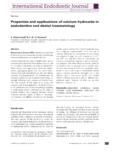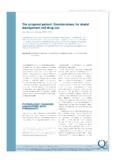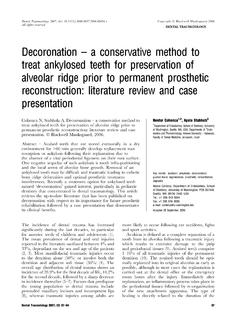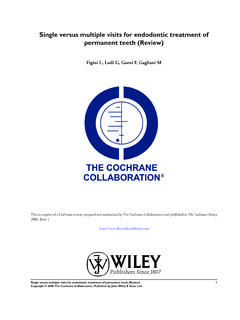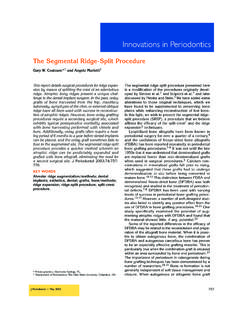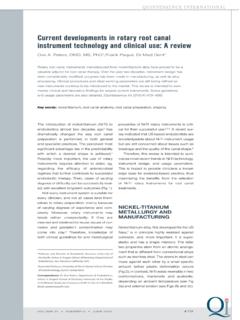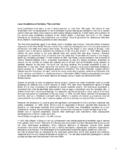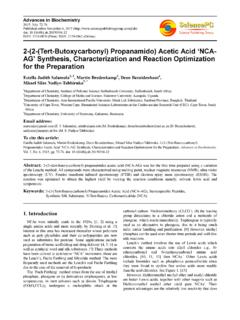Transcription of The physical characterization of a thermoplastic …
1 The physical characterization of a thermoplastic polymerfor endodontic obturationAmal Elzubaira, Carlos Nelson Eliasa,*, Joa o Carlos Miguez Suareza,He lio Pereira Lopesb,Ma rcia Vale ria B. VieiracaBiomaterials Laboratory, Instituto Militar de Engenharia, Pr Gen Tibu rcio 80, Praia Vermelha, 22290 270 Rio de Janeiro, RJ, BrazilbEndodontic Department at Universidade Esta cio de Sa , Rio de Janeiro, RJ, BrazilcEndodontic Brazilian Association, Rio de Janeiro, RJ, root canal preparation aims to remove infected debrisfrom the root canal system. The success of root canal therapydepends on related phases in root canal treatment: cleaningand shaping, sealing of the canal system and microbialcontrol. Shaping the root canal allows for more efficientdisinfections by creating a reservoir for irrigation andmedication and it also provides a space for the root canalfilling.
2 Gutta-percha is generally used as a bonded root canalobturation has many advantages, such as being a non-toxic, biocompatible, thermoplastic and retractable a new composite (ResilonTM) has been made availablefor root canal sealing. ResilonTMcan be used with all thecommon present forms of endodontic treatment. In theliterature there is no work concerning the identification ofthis composite, which is important in order to ensure clinicalaccident comprising biodegradable polymeric matrixesand bioactive ceramic fillers are used extensively in the field ofmedical application. Several polymeric/ceramic combinationsjournal of dentistry 34 (2006) 784 789article infoArticle history:Received 14 January 2006 Received in revised form2 March 2006 Accepted 6 March 2006 Keywords:ResilonTMEndodontic sealerRoot canalCanal fillingCanal therapyThermoplastic polymerObturationPolycaprolactoneRadiopa que fillersabstractObjective:To analyze a new endodontic sealer material commercially known as ResilonTMand to describe in detail the experimental techniques employed that lead to the identifica-tion of the composite :An extensive structural, thermal, and physical characterization was used toidentify a new endodontic sealer material using the following techniques.
3 Fourier transforminfrared (FTIR) spectroscopy, nuclear magnetic resonance (NMR) analysis, X-ray fluores-cence spectrometry (XRF) technique, X-ray diffraction (XRD) measurement, thermo-gravi-metric analysis (TGA) and a differential scanning calorimeter (DSC). The surfacemorphology was analyzed using a scanning electron microscope (SEM).Results:The material was identified as a composite of polycaprolactone, which is a polymerof the polyester family and bioactive glass, which is radiopaque :The ResilonTMsealer material is a thermoplastic synthetic degradable poly-mer (polycaprolactone), it contains bioactive glass. Its properties, such as strength, mod-ulus, shape-memory effect and biodegradability depend on the crystalline fraction, which isaffected in turn by conditions of crystallization. Investigation of the crystallization kineticsof PCL is of practical significance.
4 It is especially necessary to study its the dynamic and non-isothermal crystallization process.#2006 Elsevier Ltd. All rights reserved.*Corresponding author. Tel.: +55 21 25467244; fax: +55 21 Elias).available at homepage: $ see front matter#2006 Elsevier Ltd. All rights be used to confer to the composites different character-istics. They are also used for controlling properties such asbiocompatibility, water-uptake, rate of degradability andmechanical properties, making these materials suitable foruse on a wide range of biomedical applications. However, pooradhesion between the polymeric matrix and the ceramicparticles often results in an early failure in the interface and inan accelerated degradation of the composite mechanicalproperties. This degradation phenomenon is even moresignificant if composites are placed in physiological (PCL) is a biodegradable polymer that hasbeen intensively investigated as a biomedical 5It isbiocompatible, has good water, oil, solvent and chlorineresistance, a low melting point and low viscosity, it ismechanically strong and is easy to process.
5 It is used for drugdelivery, a process where drug compounds are mixed in thepolymer matrix and then they are gradually released as thepolymer is dissolved in the tissue. In the emerging field oftissue engineering, biodegradable polymers are used formaking polymer scaffolds to assist tissue and cell growthduring the formation of artificial 8In such applica-tions, biodegradable polymers have allowed for successful cellattachment, proliferation, and has good mechanical and degradation properties. Yet,the complete breakdown of this polymer can take up to 2 yearsto fully occur, rendering the use of PCL unsuitable in shortterm applications. However, the chemical structure of PCL isunusual, enabling compatible blends with a wide variety ofpolymers whilst retaining many of its own advantageousproperties. PCL can be degraded by microorganisms as well asby a hydrolytic mechanism under physiological reported by Tay et PCL is susceptible to both alkalineand enzymatic hydrolyzes.
6 They examined the susceptibilityof ResilonTM, a polycaprolactone-based root filling composite,to alkaline hydrolysis using field-emission scanning electronmicroscopy and energy dispersive X-ray analysis. The surfaceresinous component of ResilonTMwas hydrolyzed after 20 minof sodium ethoxide immersion, exposing the spheruliticpolymer structure of PCL and subsurface glass and bismuthoxychloride fillers. More severe erosion occurred after 60 minof sodium ethoxide treatment. Another study10provideddefinitive evidence that ResilonTMis biodegradable underthe attack of hydrolytic ester bond-cleaving enzymes (termedenzymatic surface erosion) that may exist as a component ofthe salivary enzymes11or as extracellular enzymes fromendodontically relevant microbes. They hypothesized thatbiodegradation of this material may also occur because ofenzymatic hydrolysis via a surface degradation mechanism,similar to that, which has been previously reported 14 The PCL material has a significantly slower biodegradationrate than other biodegradable polymers (BDP)
7 Biomaterials,making it suitable for the design of long-term implantablesystems such as Capronor, a US FDA approved toxicology of PCL has been studied as part of theevaluation of Capronor, it is currently regarded as non-toxicand tissue is especially appealing for suchapplications as it also has the lowest unit price amongst all ofthe common off-the-shelf BDP are also considered to be another importantbiomaterial within the tissue-engineering industry, and aresuitable for end applications such as devices for guided tissueregeneration and the treatment of bone defects due to theirosteoconductive 18 The aim of the present work is to study a new endodonticsealer material, namely, ResilonTM, which is being used to sealthe dental root canal system. A structural, thermal, andphysical characterization was used to identify the unknowncomposition of the and methodsThe material analyzed was a composite marketed under thebrand name ResilonTM(Pentron Clinical Technologies, Wall-ingford, CT, USA).
8 ResilonTMis a commercial compositematerial with conic shape like the available gutta-percha,which is being used to seal the root canal identify the ResilonTMchemical composition thefollowing techniques was used: a Fourier transform infrared(FTIR) spectroscopy, a nuclear magnetic resonance (NMR)analysis, an X-ray fluorescence (XRF) technique, an X-raydiffraction (XRD) measurement, a thermo-gravimetric analy-sis (TGA) and a differential scanning calorimeter (DSC). Thesurface morphology was analyzed using a scanning electronmicroscopy (SEM).The FTIR spectroscopy measurements in a 400 4000 cm 1range were performed on a 1720 Perkin-Elmer spectrometerusing the multiple internal reflectance (MIR) technique with aKRS-5 crystal (458) and a TGS detector. The spectra wereobtained at a 2 cm 1resolution, 100 scans and processed by aPerkin-Elmer IR data manager (IRDM).
9 For the C13-NMR analysis, the sample was dissolved indeuterated chloroform and filtered through glass wool beforetransferring it to the NMR tubes. Then the sample wasdissolved in CDCl3and sealed in an NMR tube. After beingdegassed, samples were analyzed using a Varian VXR 300 qualitative elemental composition of the sample (XRD)spectrum was measured with a Rigaku diffractometer with a CuKaradiation at a continuous 2uscanning of step A highvoltage of 30 kV and a current of 15 mA were used.(TGA) was performed on a Shimadzu TGA-50. Samples ofabout 10 mg were heated in air from 25 to 7008C at a heatingrate of 108 melting temperature of the sample was determined ona Perkin-Elmer Model DSC-4 equipped with a ThermalAnalysis Data Station (TADS) using standard aluminum were made on 10 mg samples in the tempera-ture range between 20 and 3508C at a scanning rate of 108C/min.
10 Nitrogen was used as a sweeping gas. The instrumentwas calibrated with model JSM 5800LV JEOL scanning electron microscope(SEM) was used to analyze the morphology of the longitudinalsurface and the transversal cross-section samples previouslycut off from the point using scissors. The samples weresputter-coated with a thin gold film in a vacuum chamberbefore of dentistry 34 (2006) 784 1shows the FTIR spectrum result where the absorptionlines were identified, using the database of the system, andthis was found to fit with 1shows thecharacteristic infrared bands of PCL, as found by otherresearch groups that fit perfectly with the FTIR spectrum result was confirmed by the C13-NMRspectrum of a sample dissolved in chloroform, as can be seeninFig. 2. The structural formula of polycaprolactone isobtained when each shift is assigned to each carbon 3shows the X-ray diffraction (XRD) spectrum of thesample indicating a well crystalline thermal and morphological properties of PCL and DSCthermographs proceeded to be 4shows that themelting point of polycaprolactone is analysis (TGA) was carried out toevaluate the degradation temperature of 5shows theweight loss till 1508C, which is associated with waterevaporation, the degradation (or decomposition) of thematerial starts at approximately point morphology cut with the scissors was observedby SEM.

